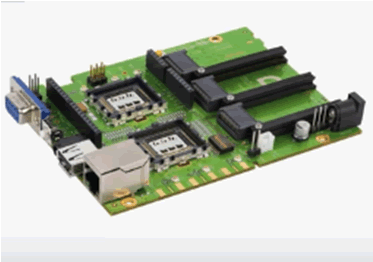RF Connectivity Platforms for M2M and IoT
The Internet of Things has achieved cost-effective mass-market implementation in consumer applications more quickly than in custom solutions for industrial automation, but now the playing field is being leveled by wireless machine-to-machine connectivity.
 Technology concepts often burst onto the scene with a big splash of possibilities followed by the sobering reality of implementation. The ability to harness real world benefits can take time to catch up with the promise, and the pace of progress is not always equal across all applications.
Technology concepts often burst onto the scene with a big splash of possibilities followed by the sobering reality of implementation. The ability to harness real world benefits can take time to catch up with the promise, and the pace of progress is not always equal across all applications.
For example, the Internet of Things (IoT) has achieved cost-effective mass-market implementation in consumer applications more quickly than in custom solutions for industrial automation (IA). Fortunately, industrial users now see the playing field being leveled by systematic approaches that simplify the nuts-and-bolts execution of wireless machine-to-machine (M2M) connectivity to exploit the full potential of true IoT implementation. Such opportunities include augmenting existing wired plant systems as well as developing entirely new wireless solutions.
M2M vs. IoT
Even though wireless M2M and IoT executions share common attributes, they are not the same. Yet, regardless of which scope best suits your unique application, ever-expanding technical options are helping to deliver desired outcomes more efficiently:
- More choices of intelligent products with built-in microcontroller units (MCUs)
- Low-power semiconductors to support battery-powered solutions
- More affordable and easily accessible connectivity options – including more broadly available Internet and Wi-Fi access
- Mesh Wi-Fi topologies that add versatility in node-intensive IA systems
Big-Picture Approaches to Small-Scale Applications
Fortunately for first-time or occasional IA system developers, there are alternatives to struggling with learning curves for the most detailed aspects of wireless technology in “smart manufacturing” systems. They allow developers to place greater focus on the business challenges at hand and less on technical implementation. They also make it easier to balance freedom of choice and technical support against the cost levels projects can afford.
For example, SimpleLink Solutions, an integrated platform from Texas Instruments, gives developers the resources needed to deliver wireless connectivity solutions without having to engineer every facet from scratch.
And for users who prefer multi-source independence in developing custom RF solutions with components and capabilities from a range of manufacturers, Project mangOH provides open-source IoT hardware and software platforms for prototyping and building industrial-grade wireless solutions.
An Integrated Plug-and-Play Approach
The TI SimpleLink platform offers a comprehensive set of compatible building blocks for connecting nodes, hybrid gateways, and connectivity to the Cloud for true IoT implementation. It addresses built-in security at all layers – hardware, software, and connectivity. It is even sensitive to low-power requirements, allowing for 10-year battery-power as well as harvested-power devices to be used in difficult-to-access locations.

Texas Instruments SimpleLink Development Kits (left) and SensorTags (right) provide ready-to-assemble solutions for a broad range of applications in IA and beyond.
The platform’s compatibility with a broad variety of wired and wireless standards makes it easy to leverage existing IA system investments as well as implement optimal new solutions based on diverse requirements. Available sensing technologies accommodate environmental (light, temperature, humidity), process (chemical, power, gas, material composition, pressure, position/motion), and personnel applications (biosensing, proximity, occupancy).
Open-Source Flexibility

As a fully integrated solution with multiple connector options, mangOH offers flexibility for prototyping custom applications using popular wireless protocols.
The mangOH IoT open source hardware platform offers industrial sensor-to-cloud capability for building battery-powered wireless IoT solutions – from an initial concept, through prototype, to production. Purpose-built for cellular applications – 2G-, 3G-, or 4G-compatible – the mangOH concept is designed to accommodate low-power wide-area technology standards. Those standards are expected to take a more prominent role in IoT applications by reducing device and service costs while extending battery life and transmission reach.
According to the Project mangOH website, “mangOH designs deliver 90% of your prototype out of the box, so that software developers can build reliable IoT solutions easily and hardware designers can customize it to create new hardware IoT devices easily.” Its industrial-grade components can be used not only for prototyping, but also for commercial execution in most industrial use cases. This means software developed for prototypes using the Linux-based open-source Legato software platform can be re-used in the commercially deployed version without license fees, saving time and cost.
The mangOH Green Eurocard format incorporates three industrial-grade QSFP+ IoT connectors, two CF3 connectors for wireless modules and application processors, three U.FL antenna connectors, as well as one each of USB 2.0 Micro, RS-232/Serial, RJ-45/Ethernet, and audio jack connectors. On-board accelerometer and gyroscope sensors, a Micro SD card slot, and one Arduino-compatible connector for supporting a wide range of Arduino shields complete the hardware package. A second reference design – mangOH Red, one quarter the size of the mangOH Green card – has recently been introduced to enable even more power-efficient designs.
Connection Options For Multiple Needs
Whether you use a comprehensive platform or ad hoc development for RF implementation, application demands can drive communications protocol compatibility. The location and relative accessibility of sensor nodes come into play, as the power requirements of various protocol options and executions range from AA or AAA batteries down to coin cell batteries or even energy harvesting opportunities.
- For Personal Area Networks (PAN), Bluetooth Smart low-power requirements work well with battery-powered sensors to transmit data from remote, hard-to-access locations.
- For Local Area Networks (LAN), 6LoWPAN is well suited to factory automation systems. It offers direct IP connectivity for small, low-power, limited-processing power devices – a real benefit for implementing networks of sensors with individually assigned IP addresses. The ZigBee protocol combines the benefits of mesh topology with low power consumption. Wi-Fi lets you take advantage of existing infrastructure for 100Mb/s transmission and control of remote equipment.
- For Neighborhood Area Networks (NAN) where distance is a concern, proprietary Sub-1 GHz solutions provide low-power, robust, and long-range capabilities for extending networks up to 22 miles (35km).
A hybrid IA solution can use multiple protocols to accommodate multiple networks within one plant environment. For example, you might use less complex, less expensive wired or wireless PAN technology to handle on-site connectivity with individual nodes, then link through a gateway to empower broader IoT connectivity. This can be particularly useful when building upon existing IA solutions that use wired Ethernet technology.
For physical implementation at each sensor or node, a variety of compact RF connectors accept coaxial cable connections to external antennas for the wireless transmitter modules. Small form factor microminiature connectors are even finding acceptance in wearable technologies.
Author Peter Antoniewicz is a veteran freelance writer who covers high-tech and business-to-business topics for a variety of corporate, agency, and editorial clients. He has written on subjects ranging from embedded computing, electronics, and software to ag-chem, medical imaging, engineered solutions, industrial products, and business services. Email him at [email protected].




